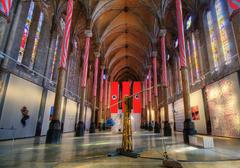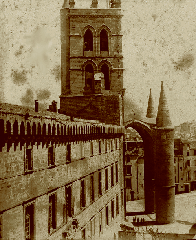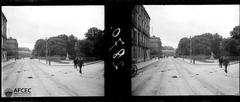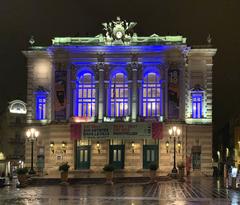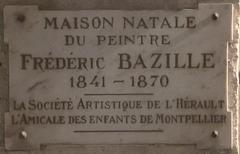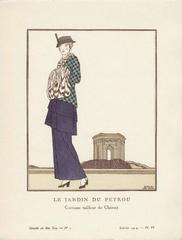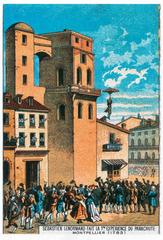
Montpellier 2 University Visiting Guide: Hours, Tickets, and Nearby Historical Sites
Date: 03/07/2025
Introduction
Montpellier 2 University—historically known as Université Montpellier II until its 2015 merger into the University of Montpellier—stands as a symbol of academic excellence and cultural heritage in southern France. With a legacy that stretches from its 1809 founding and roots in the medieval medical school of 1220, the university’s historic campuses, botanical gardens, and specialized museums offer a fascinating destination for visitors. Whether you’re a traveler passionate about science, history, and architecture or simply eager to experience the vibrant student life of Montpellier, this guide will help you navigate the university’s attractions, understand practical details like visiting hours and ticketing, and explore nearby historical sites (Montpellier Tourism Office, Campus France).
Contents
- Introduction
- Historical Overview
- Visiting Hours and Tickets
- Getting to Montpellier 2 University
- Campus Layout and Key Attractions
- Photographic Highlights
- Scientific Heritage Sites
- Accessibility and Visitor Services
- Accommodation and Dining
- Special Events and Academic Open Days
- Exploring Montpellier’s Historical Sites
- Practical Tips and FAQs
- Useful Contacts and Resources
- Weather, Packing, and Budgeting
- Conclusion
- Sources and Further Reading
Historical Overview
Academic and Cultural Significance
Founded in 1809, with its lineage grounded in the renowned Faculty of Medicine established in 1220, Montpellier 2 University played a pivotal role in shaping Montpellier’s reputation as a center for scientific and medical advancement. Its merger in 2015 with Montpellier 1 University consolidated these traditions and expanded its academic influence across science, technology, medicine, law, and management (University of Montpellier, University of Montpellier Visitors Guide, PDF). The university’s alumni list includes such luminaries as Rabelais and Nostradamus (CN Traveller).
Visiting Hours and Ticket Information
Campus and Museum Access
- General Campus Access: Monday to Friday, 8:00 AM–6:00 PM. Campuses are closed to the public on weekends and public holidays.
- Jardin des Plantes: Open daily, 8:30 AM–6:30 PM (seasonal variations possible).
- Conservatory of Anatomy (at the Faculty of Medicine): Guided tours available Wednesdays and Saturdays, 10:00 AM–4:00 PM; advance booking is advised.
- Audiocampus (Faculty of Pharmacy): Open Monday to Friday, 9:00 AM–5:00 PM.
Ticketing
- Campus Grounds and Jardin des Plantes: Free entry.
- Anatomical Museum: Guided tours—€5 adults, €3 students/seniors, free for children under 12. Tickets can be reserved online or at the visitor center.
- Special Events and Open Days: Some events require registration or tickets—check the University Events Calendar for details.
Getting to Montpellier 2 University
By Air
Montpellier-Méditerranée Airport, about 10 km from the city center, provides direct flights from major European hubs. Shuttle buses, taxis, and car rentals connect visitors to downtown and campus locations (Nomads Travel Guide).
By Train
Two main stations—Montpellier Saint-Roch (city center) and Montpellier Sud de France (outskirts)—link the city to Paris, Lyon, Marseille, and beyond via high-speed TGV. The tram system provides easy access from both stations to university campuses (Nomads Travel Guide).
By Public Transport
Montpellier’s tram and bus network is efficient and eco-friendly. Tram Line 1 stops at “Université des Sciences et Lettres” and “Stade Philippidès” for the main campus; Lines 3 and 4 are also noted for their artistic designs (PlanetWare, Campus France).
Campus Layout and Key Attractions
Distributed Campuses
- Campus Triolet: Faculty of Sciences, Polytech, and IAE.
- Site Richter: Faculty of Economics, MOMA, and IPAG.
- Faculty of Medicine: Home to the historic Conservatory of Anatomy.
- Faculty of Pharmacy: Features the interactive Audiocampus.
- Other Sites: Law, Sports, and Dentistry faculties spread throughout the city (University of Montpellier Visitors Guide, PDF).
Key Scientific Heritage Sites
- Jardin des Plantes: France’s oldest botanical garden (est. 1593), an oasis for plant lovers and history buffs. Restoration projects preserve its centuries-old trees (University of Montpellier Heritage).
- Conservatory of Anatomy: A museum with anatomical wax models, rare medical instruments, and manuscripts—open for guided tours.
- Modern Research Facilities: Recent renovations and innovative labs underscore Montpellier’s ongoing scientific contributions.
Photographic Highlights
- Architectural contrasts: medieval halls and contemporary buildings.
- Botanical gardens: tranquil paths, ancient trees, and greenhouse collections.
- Public art installations and sculptures scattered across campus.
Accessibility and Visitor Services
- Mobility: Campuses offer ramps, elevators, and step-free tram access (Campus France PDF).
- Welcome Desk (SAIEC): Multilingual support, campus maps, info on guided tours and events (8 rue de l’École Normale, open Mon–Fri, 9am–4pm).
- WiFi: Eduroam network for visitors with institutional credentials; temporary passes available at the Welcome Desk or library.
- Health and Safety: On-campus medical center and pharmacy; security staff and emergency points.
Accommodation and Dining
Where to Stay
- Hotels and Residences: A wide range in the city center and near campus (Montpellier Tourist Office).
- Youth Hostels: Affordable for students and backpackers.
- Long-Term Options: CROUS student housing (limited availability for researchers), private rentals via Lokaviz and La Carte des Colocs.
- Booking Tips: Reserve early during term starts and summer festivals (Holidify).
Food and Amenities
- University Restaurants (RU): Affordable, with meal tickets at entry.
- Campus Cafés and Bakeries: Quick snacks and local fare nearby.
- City Dining: Explore Montpellier’s diverse cuisine, including Languedoc wines.
Special Events and Academic Open Days
Montpellier 2 University and the larger University of Montpellier regularly host:
- Science fairs, public lectures, and exhibitions.
- International conferences, such as the 30th International Panel Data Conference.
- Cultural festivals and student welcome parties (Campus France).
- Art exhibitions, dance performances, and social events organized by student associations like ESN Montpellier.
Check the university’s events calendar for up-to-date listings.
Exploring Montpellier’s Historical Sites
While at Montpellier 2 University, don’t miss these nearby attractions:
- Place de la Comédie: The lively heart of Montpellier, known for its oval shape and vibrant atmosphere.
- Promenade du Peyrou: An elevated park with panoramic city views.
- Saint-Pierre Cathedral: Gothic architecture and imposing towers.
- Musée Fabre: A leading art museum in southern France (The Crazy Tourist).
- Écusson District: Medieval streets, historic mansions, and bustling cafés.
- The Medieval Mikve: One of Europe’s rare preserved Jewish ritual baths.
All sites are accessible on foot or by tram, making them easy additions to your itinerary.
Practical Tips and FAQs
Essential Information
- Language: French is primary; English spoken at main visitor points.
- Currency: Euro (€); cards widely accepted.
- Safety: Low crime; standard travel precautions.
- Weather: Mediterranean climate—hot summers, mild winters. Pack accordingly (PlanetWare).
Frequently Asked Questions
Q: What are the main visiting hours?
A: Monday–Friday, 8:00 AM–6:00 PM for campuses; Jardin des Plantes, daily 8:30 AM–6:30 PM; museums as scheduled.
Q: Are tickets required?
A: Campus and gardens—free. Special events or guided tours—tickets/registration may be required.
Q: Can I book a guided tour?
A: Yes, via the Welcome Desk or online; advance booking recommended.
Q: Is the campus accessible for visitors with disabilities?
A: Yes, most areas have step-free access and facilities.
Q: Where can I stay nearby?
A: Hotels, hostels, and student housing are available; book early during busy periods.
Useful Contacts and Resources
- University Welcome Desk (SAIEC): 8 rue de l’École Normale, 34090 Montpellier. Phone: +33 (0)4 67 41 67 87. Email: [email protected] (Campus France)
- Montpellier Tourist Office: montpellier-tourisme.fr
- Campus France Montpellier: 87 avenue Jacques Cartier, 34000 Montpellier (Campus France PDF)
- University of Montpellier Visitors Guide (PDF): Download here
Weather, Packing, and Budgeting
- Weather: Mediterranean—light summer wear, jacket for spring/fall evenings, sun protection.
- Budgeting: Moderate costs—hotels €40–€130/night, cafeteria meals €3–€7, tram ticket €1.60, discounts for students (Holidify).
- Connectivity: Free campus Wi-Fi; SIM cards available in the city.
Conclusion
Montpellier 2 University offers much more than an academic experience—it is a gateway to centuries of scientific and cultural achievement deeply woven into the fabric of Montpellier. From its historic faculties and lush botanical gardens to its vibrant events and proximity to iconic city landmarks, visitors can immerse themselves in a unique atmosphere where tradition meets innovation. Plan your visit with this guide, consult official resources for up-to-date information, and make the most of your stay in this dynamic city.
For the latest updates, event notifications, and personalized assistance, download the Audiala Mobile App. Explore related posts on Montpellier’s culture, student life, and travel tips, and follow us on social media for insider news.
Sources and Further Reading
- University of Montpellier, 2025, Official Website
- Montpellier Tourism Office, 2025, Visitor Information
- Campus France, 2025, Montpellier City Guide
- University of Montpellier Visitors Guide (PDF), 2022
- University Events Calendar, 2025
- Audiala Mobile App, 2025
- Holidify
- PlanetWare
- The Crazy Tourist
- Nomads Travel Guide
- Campus France PDF
- ESN Montpellier


